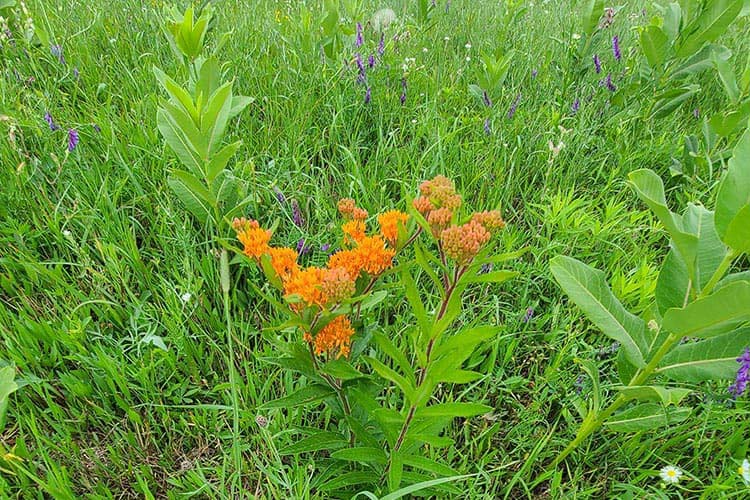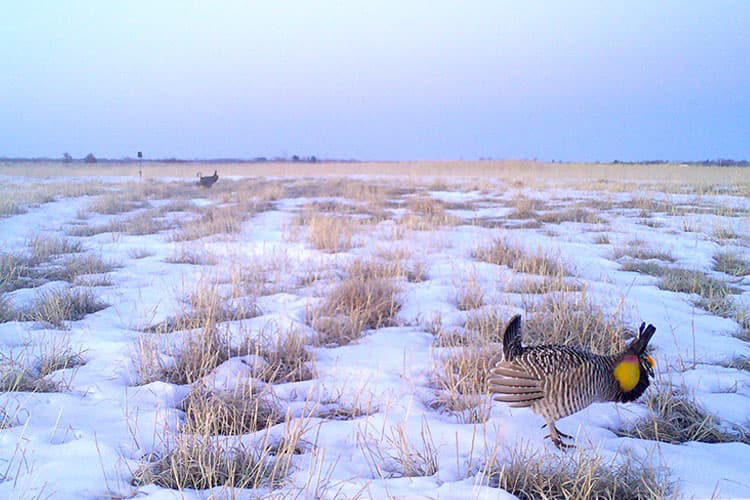Butterflies, bees, and prairie chickens have a new place to call home in the Buena Vista Grasslands of Portage County, Wisconsin. The Buena Vista area in central Wisconsin is a former marsh once dominated by tamarack, black spruce and cattails that is now a mix of irrigated cropland and grasslands.
It is one of the most extensive grasslands east of the Mississippi River and one of the few remaining areas in Wisconsin considered home to the greater prairie chickens. Found only in North America, the greater prairie chicken is listed as a threatened species in Wisconsin and relies on grasslands for habitat.
In 2005, USDA Natural Resources Conservation Service (NRCS) set out to enroll 278 acres of irrigated cropland in the area into the Wetlands Reserve Program (WRP), which is similar to the Agricultural Conservation Easement Program (ACEP) now available to producers. NRCS met with landowners Robert and Germaine Patrykus and Dave and Kelly Beggs of Bancroft, Wisconsin, about options for the irrigated marginal cropland they owned.
At the time, the landowners were transitioning from growing potatoes to carrots. This tract of land was not ideally suited for carrots due to its drainage and soil properties. Discussions between local NRCS staff and the two families ultimately led to them enrolling their land into a permanent easement. In 2007, they began restoration work on their wetlands and uplands.

Unfortunately, in the following decade, the upland areas became a monoculture of bromegrass, with scattered patches of goldenrod and spotted knapweed. While this provided marginal habitat for pollinators and other upland species, the lack of diversity was not ideal for supporting pollinators and birds.
The Patrykus and Beggs families approached the local NRCS Service Center about further enhancing some of the upland area to butterfly habitat. Local NRCS partnered with Pheasants Forever, a non-profit conservation organization that aids in reestablishing upland wildlife habitat throughout the United States. The NRCS staff, a Pheasants Forever biologist, and landowners developed a plan using dedicated WRP funding to establish a 10-acre pollinator planting for part of the uplands.

A multi-species, pollinator friendly seed mix of Indian grass and little bluestem, along with several native forbs, i.e., butterfly weed, common milkweed, black-eyed susan, purple prairie clover, bergamot and many others, were chosen for the site based on the area’s soil properties.
Through the landowner’s dedicated hard work and patience and partnership with NRCS and Pheasants Forever, this area is now a lively prairie with many thriving grassland species and a multitude of pollinators. On a recent visit early this fall, NRCS staff saw many bees and butterflies enjoying the blooming flowers. Bobolinks, meadowlarks, a burrowing owl, and several prairie chickens were also observed. This restored habitat is a win for the landowners, partners, and the natural resources we all enjoy.
The plant species diversity increases each year. With the landowner’s interest in the flowers and plants and the butterflies and birds they attract, this prairie should continue to improve and provide habitat for a variety of species for years to come.
USDA offers a variety of conservation programs that help you plan and implement conservation practices on your farm, ranch, or forest. Learn more about putting conservation to work on your operation directly from farmers, ranchers, and forestland owners applying them through our Conservation at Work video series.
Kevin Halvorson is a Soil Conservation Technician with NRCS in Stevens Point, Wisconsin.


